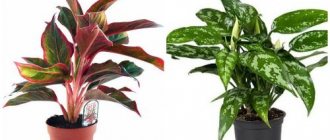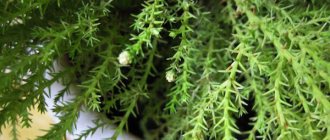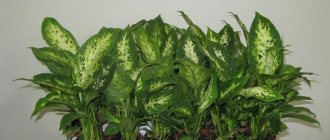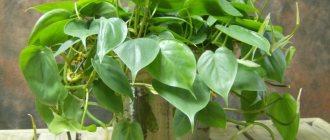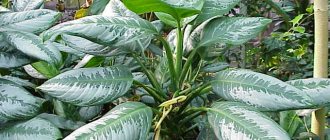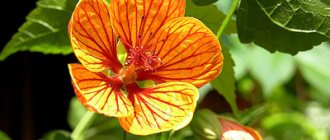Aphelandra (Aphelandra) is a tall herbaceous shrub - a frequent luxurious “guest” of home greenhouses, originally from the American tropics.
Under home breeding conditions, the height of a representative of the Acanthus family reaches 30-70 cm. It is characterized by rapid growth of leaves and shoots (more than 4 per year). The lifespan of young plants is no more than 2 years.
It is distinguished by large spike-shaped inflorescences and dark green foliage with a waxy tint, topped with white or cream-colored veins.
Domestic flower growers are familiar with the perennial as a long-blooming domestic ornamental crop. The flowering phase occurs at the end of summer or beginning of autumn and lasts more than one month.
| High growth rate. In one year there are 6-7 new leaves. |
| It blooms in summer, but with high humidity it can bloom in winter. |
| Aphelandra blooms in summer. Flowers with yellow inflorescences. |
| Annual plant. Blooms for one year. Next, the plant is cut. |
Homeland of the plant
Aphelandra protruding is an evergreen shrub from the Acanthus family. There are about 170 species. Common in the American tropics and less common in the subtropics. Under natural conditions it reaches a height of two meters, at home – no more than 1.3 meters. This heat-loving plant received a lot of moisture in the wild, so growing it at home will not be easy.
Aphelandra - an ornamental tropical plant
Description
Aphelandra or Aphelandra (transcription from the Latin Aphelandra) is a genus belonging to the Acanthaceae family and includes 200 species of angiosperms. These are herbs, subshrubs and shrubs growing wild in the tropics/subtropics of Central and South America.
Home representatives of Aphelandra are low, beautiful bushes from 30 to 70 cm with straight stems. One of the main decorations of plants is large shiny oval leaves, located oppositely on the stem and having a smooth or prickly surface. On the dark green leaf plastic, fairly wide veins of white or yellowish color are clearly visible. Small flowers are collected in 4-angled spike-shaped inflorescences, while large and hard bracts of a contrasting shade enhance the decorative nature of the flowering. The color scheme of aphelandra depends on the species: the bracts can be green or all shades of yellow, and the color of the flowers varies from light yellow to scarlet and bright red. Flowering occurs from the second half of summer to September and lasts from 7 to 60 days, depending on the species.
History of appearance in Europe
Aichrizon flower: care and flowering at home
After travelers brought the decorative aphelandra flower to Europe, it acquired the status of a houseplant. They began to breed it in greenhouses due to the harsh winters. In conditions close to the tropics, varieties of aphelandra Roeslia, tetrahedral, Sinclair, most beautiful and many others are grown. Several varieties of aphelandra squarossa are cultivated: Louisae, Dania, Leopoldii.
Pink aphelandra bloomed
Use as a houseplant
Two species have adapted best to the new conditions: aphelandra protruding and aphelandra orange.
Aphelandra orange is rarely found on sale. It is more suitable for the home, thanks to its small growth and long flowering, which under good conditions lasts one and a half weeks: from June to November.
Houseplant Aphelandra Cuarossa
Features of caring for aphelandra at home
Aphelandra is a very capricious and demanding plant; it does not like drafts or dry soil. Any violation of the requirements of this beauty leads to slow growth or illness. What are these needs? To avoid problems during the growing process, you need to know how to care for aphelandra at home.
Temperature
To create comfortable conditions for the aphelandra squarrosa plant at different times of the year, you need to maintain the required temperature in the room. In summer it should not be higher than 25 degrees, in spring and autumn - about 20. In winter, the thermometer should not fall below 16 degrees. When ventilating the room, you should temporarily remove the flower to a draft-free place.
Lighting
Although the leaves and flowers of aphelandra love warmth and light, they must be protected from direct rays of the sun. To do this, the pot with the plant should be placed on windows facing east or west. The most suitable option is diffused lighting. In winter, during the dormant period, the flower pot can be removed from the window in a bright place.
Watering
To ensure the normal functioning of a flower, it must be watered according to a certain schedule. If you divide watering by stages of development, it will happen like this:
- Stage 1: growth – 2 times a week;
- Stage 2: flowering – once every 2 weeks;
- Stage 3: restoration after flowering – once a month;
- Stage 4: beginning of growth – 2 times a week.
In summer, the soil requires abundant watering, in the autumn-winter period it is necessary to water as needed, but do not allow the earthen clod to dry out.
Caring for aphelandra at home
Spraying
It is necessary to periodically spray the leaves and flowers - this will create a certain microclimate of the place where it is grown. The plant needs such water treatments on summer days (2 times a day) if the heat lasts for a long time.
Humidity
On winter days, caring for the aphelandra flower at home is complicated by the fact that it is necessary not only to maintain the desired temperature, but also not to dry out the earthen lump in the pot. To prevent the leaves from drying out, the flower should not be kept on the windowsill when the radiator is very hot. If the air is very dry, you can use an artificial humidifier.
Important! Considering the fact that the aphelandra flower is the ambassador of all ornamental tropical plants of the Acanthus family, it is very demanding about a sufficient amount of humidity in the apartment. Excess water in the soil can also lead to its death. It is necessary to maintain a balance of temperature and humidity.
Priming
The indoor plant aphelandra protruding requires light, breathable soil for good growth and lush flowering. The best composition is considered to be: peat or humus (2 parts), coarse sand (1 part). Sometimes other soil components are used: leaf or clay-turf soil, charcoal or bone meal is added. But sand is a must.
Interesting fact. Aphelandra can be grown hydroponically, that is, a water-mineral composition without soil. This method of growing plants was used in Ancient Babylon to create the famous Hanging Gardens of Babylon, as legend has it.
Feeding
A necessary point in caring for aphelandra is the application of fertilizers. It must be fed with fertilizers containing phosphorus, nitrogen and potassium from March to November at intervals of 2 times a month. During the dormant period, nitrogen fertilizers can be applied to maintain good foliage shape. During growth, fertilizers are useful for ornamental deciduous plants, and during active flowering - for ornamental flowering ones.
Temperature
As we have already mentioned, domestic aphelandra is quite capricious and requires some care. First of all, take care of the absence of drafts and compliance with temperature parameters.
For example, in winter, fifteen degrees of heat is enough, in the demi-season period - about twenty. During the summer months, keep the flower at about 24 degrees Celsius.
When and how does it bloom
To know well how to care for aphelandra at home, you need to study all phases of its growth.
The beginning of the flowering of Aphelandra protruding
Types and forms of flowers
The shapes of aphelandra flowers depend on the variety. Most often, the flowers of the plant are small and inconspicuous, but the flower stalks are simply luxurious. They grow in the shape of a spike or pyramid and are bright yellow, orange or red.
Flowering period
The most important time for which a plant is grown is the flowering time. The first aphelandra flowers begin to bloom in June and delight everyone for 6 weeks. The amount of color depends on the age of the plant.
Important! Once the color is complete, it must be removed to prevent the fruit from appearing. Why? Because after its appearance, the plant can complete its life cycle. It is necessary to remove flower stalks with caution; their juice is poisonous.
It's time for the aphelandra squarossa plant to bloom lushly
Brief “biography” of squarrosa
It was not for nothing that we used the name “squarrosa” in the title, because this is what aphelandra is called in its homeland - in Mexico. This representative of the flora belongs to the Acanthus family. Of all the existing species, Aphelandra squarrosa protruding is the only one that is cultivated in our country at such a high level.
- Leaves: They have an oval-elliptical shape, are large, reaching 0.3 meters in length. The leaf plate has a glossy structure. The main color of the leaves is a dense green, dark shade. Each leaf has clearly visible, contrasting white-silver veins. If you turn the leaf over, you will see that the color of its back side is not nearly as intense as the color of the front.
- Flowers. Double-lipped, tubular. Collected in inflorescences that resemble spikelets in appearance. The length of the inflorescences can reach 0.3 meters. The aphelandra bract is always variegated orange and very bright. But the color of the flowers themselves is yellow.
The flowering of aphelandra is a rather lengthy process: under favorable conditions, exotic flowers bloom at the end of spring and fade towards the end of autumn.
How does Aphelandra reproduce?
At home, flower propagation is possible by seeds and cuttings.
Germination of seeds
Sow well-ripened seeds in a container with a mixture of leaf soil and sand. The soil needs to be well moistened with warm water and a weak solution of manganese. Germination is carried out in a greenhouse or in a house at a temperature of +25 degrees. The soil must be ventilated regularly. When the sprouts grow, transplant them into flower pots.
Rooting cuttings
Reproduction by cuttings is the most accessible. In spring, select an annual shoot from the plant. Cut it so that it has 2-3 leaves and treat it with a root formation stimulator. Plant in a pot with peat-sand soil or in a greenhouse. Cover with glass or cellophane to create a greenhouse effect. Ventilate daily for 10 minutes. Rooting occurs at 22 degrees Celsius for 1.5-2 months. Then the cuttings that have given roots are planted in flower containers.
Reproduction
Aphelandra propagates by seeds and cuttings (apical and leafy).
- Seeds are collected in early spring and immediately sown in prepared soil. Create a small greenhouse, not forgetting to ventilate and water. The young plant should not be allowed to freeze. The optimal temperature is 20 - 25 0.
- The apical cuttings are cut in early spring and rooted in damp sand. Create a greenhouse and maintain the temperature at 20 - 25 0C. After a month, you can transplant the plant into the ground.
- Leaf cuttings are cut in the fall. To do this, the leaves are cut off together with the axillary bud and immediately rooted in a mixture of peat and sand. They create a greenhouse and monitor the temperature.
Aphelandra is not a plant for everyone. Not everyone will be able to pay enough attention to her and monitor her condition. And those few flower growers who preferred this particular guest from the tropical forest will be able to appreciate the beauty of this bush. Bright flowers combined with large leaves can brighten up the most dull rooms.
Transplanting a plant
It is recommended to replant Aphelandra. Young plants in the spring, and grown bushes - once every 2-3 years. If you need to replant a newly purchased specimen or plant sprouted seeds, you need to perform several actions common to all cases:
Transplanting aphelandra is not an easy task.
- Buy or prepare your own substrate consisting of turf, peat and river sand in a ratio of 2:1:1.
- Be sure to disinfect it.
- Pour drainage made of expanded clay or small pebbles into the bottom of the pot for ¼ of the pot.
- Pour soil 4 cm thick on top for planting adult plants.
- Prepared bushes with peeled stems and washed roots are placed vertically in the ground, its remains are added and compacted well.
- For planting seedlings or purchased young plants, the soil in pots is prepared according to the same scheme, only it is laid out all at once.
- After this, plants are planted in it and watered well.
On a note. To transplant aphelandra, you need to choose a container 5-7 cm higher than the previous one. If parts of the root have been removed, the plant must be watered with Kornevin solution twice: after planting and after 14 days.
Rest period
The resting period of Aphelandra begins in mid-autumn and lasts until the end of winter.
At this time, the plant is provided with a temperature regime of +13o - +15o (only for aphelandra protuberans, for other varieties it remains at least +20o!) while maintaining daylight hours for at least 10 hours. Watering is reduced, but the earthen ball should not be allowed to dry out. Water the plant when the top of the soil dries out. Spraying is also reduced as much as possible.
At the end of winter, the temperature is gradually increased to +22° - +24°, watering and spraying are increased, and fertilizing begins. At the beginning of spring, the plant is pruned and a bush is formed.
The plant quickly forms a lush bush with dense greenery. To give a beautiful shape, pruning . Pinch the tops of the plant to provoke the growth of side shoots - this is done throughout the entire growing season.
Often during a season, aphelandra grows so much that the lower part of the branches sheds the lower old leaves, the trunk becomes bare and the plant does not look very attractive. To prevent this, at the end of winter, before the period of active growth, all old branches are cut off, leaving small (about 20 cm) stumps with dormant buds, from which new shoots will grow in the spring. After pruning, it is recommended to spray the plant and put a plastic bag on top for better and faster recovery.
Cut tops can be easily rooted and planted in the same pot to add extra density.
Replanting is required once a year for young plants. Adult plants are replanted less frequently - once every 3-4 years.
Possible problems in growing aphelandra
Quite often, a number of problems arise after transplants. On a global scale, the reasons for their appearance can be divided into 2 groups: violations in care or the presence of diseases or pests. To decide on actions, you need to identify the cause.
Leaves fall or wither due to little watering, cold drafts, too much sun or lack of mineral nutrition.
Leaves become smaller in a cramped pot or when there is a lack of fertilizer.
The brown edge of the foliage indicates a lack of moisture, brown spots indicate a lack of fresh air or sunburn.
If damaged by thyroid gland, mealybug or brown rot, the plant may not only lose its leaves, but also die if special measures are not taken urgently. Aphids also cause enormous harm to aphelandra, attacking it in entire colonies.
Gardeners' attention to growing southern ornamental plants on their plots is growing every day. Spring and summer in most regions are short and not warm enough. Residents of the tropics need a lot of sun, warmth and abundant moisture. Lovers of indoor plants want to have a small corner of tropical paradise in their apartment. Aphelandra is best suited for the role of queen of this paradise.
Trimming
Even “in captivity” aphelandra grows quite quickly, so it needs annual formative pruning. It is carried out at the end of winter, before the start of the intensive growth phase. In a young flower, it is enough to pinch the upper shoots by 2-3 buds to achieve greater splendor and “bushiness”.
Mature plants lose their decorative appearance, dropping their lower leaves, and the trunk becomes unattractively elongated. If pinching the upper shoots does not help, cut everything off, leaving “stumps” about 30 cm long. Then put a plastic bag on the pot, seal it tightly and leave the aphelandra in this form for 3-4 weeks, spraying it 2-3 times daily.
When this procedure does not give the desired result, the only way out is to cut off the apical cutting and re-root.
Common problems when growing aphelandra - table
| Description of the problem | Most likely causes |
| Withering and falling leaves | Insufficient watering. Even a short-term lack of moisture causes the aphelandra to shed its leaves. This may also be a consequence of low temperatures and/or the presence of cold drafts in the room. Most often, it is no longer possible to save the plant. Grow new things from cuttings. |
| The tips of the leaves turn brown, curl and dry out. | The air humidity in the room is not high enough. Spray the plant more often, place wet moss, peat, and expanded clay in the tray. Move the pot away from working radiators. |
| Individual sections of the leaf blade change color to brownish. | This is either a sunburn from direct sunlight on the leaves, or a consequence of insufficiently clean air. Ventilate the room more often. |
| The leaves become smaller, deformed, lose their brightness, and wither. | The reason is insufficient, excessive or incorrect fertilization. Examine the plant to determine which micro- and macroelements it is lacking. Do not exceed the concentration recommended by the manufacturer when preparing the solution. |
| Rot at the base of the trunk and leaves | Excessive watering. Increase the intervals between them and reduce the watering rate. Be sure to drain any excess water from the pan. If the plant is severely damaged, it is worth removing it from the pot and inspecting the roots for rot. In case of local damage, leaves with traces of rot are cut off, and the roots are given special attention during the next transplant. |
| The stem becomes thinner and longer, the inflorescence does not form or becomes deformed. | Aphelandra lacks light. Move it to where there is more sun, or use fluorescent lamps for additional lighting. |

